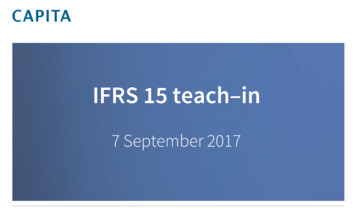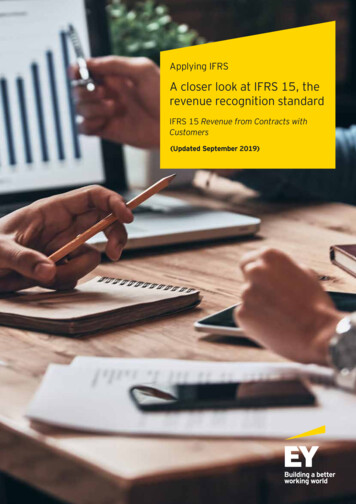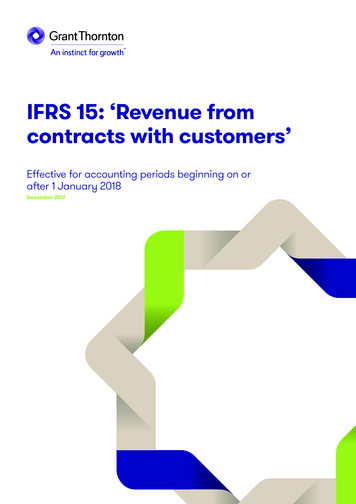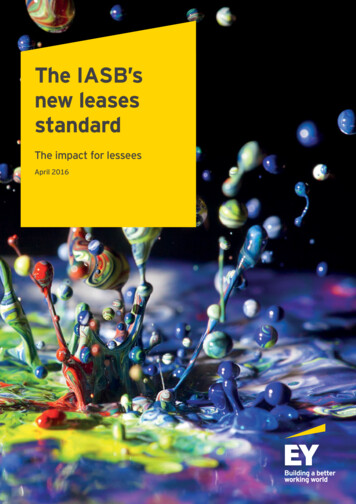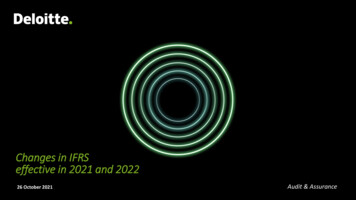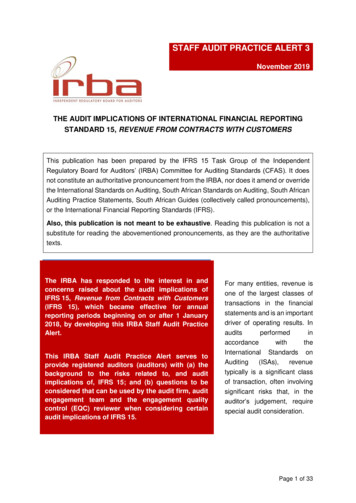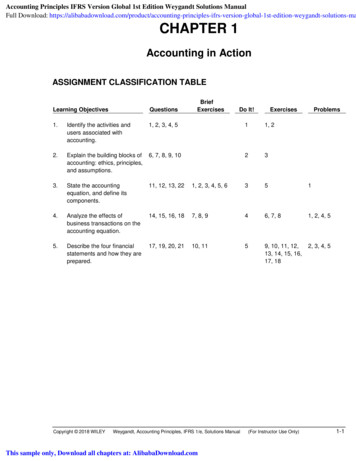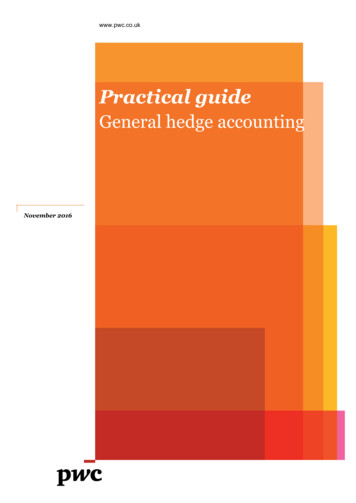
Transcription
www.pwc.co.ukPractical guideGeneral hedge accountingNovember 2016
Practical guideContents1.Introduction11.1.Overview of IFRS 911.2.General hedge accounting12.Hedge accounting32.1.What is hedge accounting?32.2.Accounting for hedges33.Qualifying criteria for hedge accounting63.1.Formal designation and documentation73.2.Eligible items73.3.Hedge effectiveness73.4.Discontinuation of hedge accounting114.What can be designated as hedging instruments?144.1.Derivative financial instruments154.2.Non-derivative financial instruments measured at fair value through P&L154.3.Embedded derivatives154.4.Hedging with purchased options154.5.Hedging with forward contracts164.6.Accounting for currency basis spreads175.What can be designated as hedged items?185.1.Definition of hedged item185.2.Risk components of non-financial items185.3.Hedging groups of net positions205.4.Hedging layers of a group215.5.Aggregated exposures216.Alternatives to hedge accounting226.1.Extended use of fair value option for ‘own use’ contracts226.2.Option to designate a credit exposure at fair value through P&L227.Disclosures248.Effective date and transition25General hedge accountingPwC Contents
Practical guide1. Introduction1.1.Overview of IFRS 9The International Accounting Standards Board (the ‘Board’) has been reviewing accounting issues that haveemerged as a result of the global financial crisis, including those identified by the G20 and other internationalbodies such as the Financial Stability Board. As part of this, the Board commenced its project to replace IAS 39and sub-divided it into three main phases, as described below:1.Classification and measurement – The Board completed the classification and measurement forfinancial assets in 2009 and for financial liabilities in 2010. However, the Board has since proposed limitedmodifications to the original requirements. An exposure draft on these limited amendments was issued inNovember 2012. Currently the Board expects to finalise the limited amendments during the firsthalf of 2014.2.Impairment – The Board issued an exposure draft in March 2013 proposing to replace the current‘incurred loss’ with an ‘expected loss’ impairment model. Currently the Board expects to finalise this phaseduring the first half of 2014.3.Hedge accounting – The new requirements on hedge accounting were finalised in November 2013. It isimportant to note that, while these changes provide the general hedge accounting requirements, the Boardis working on a separate project to address the accounting for hedges of open portfolios (usually referred as‘macro hedge accounting’).This practical guide focuses on the third phase of IFRS 9, ‘Financial Instruments’, covering generalhedge accounting.1.2.General hedge accountingThe rules on hedge accounting in IAS 39 have frustrated many preparers, as the requirements have often notbeen linked to common risk management practices. The detailed rules have, at times, made achieving hedgeaccounting impossible or very costly, even where the hedge has reflected an economically rational riskmanagement strategy. Similarly, users have found the effect of the current rules for hedge accounting less thanperfect, and they have sometimes struggled to fully understand an entity’s risk management activities based onits application of the hedge accounting rules. So, users and preparers alike supported a fundamentalreconsideration of the current hedge accounting requirements in IAS 39.The new standard, IFRS 9, improves the decision-usefulness of the financial statements by better aligninghedge accounting with the risk management activities of an entity. IFRS 9 addresses many of the issues inIAS 39 that have frustrated corporate treasurers. In doing so, it makes some fundamental changes to thecurrent requirements, by removing or amending some of the key prohibitions and rules within IAS 39.Overall, we believe that, by placing greater emphasis on an entity’s risk management practices, the publicationof the third phase of IFRS 9 is an improvement for hedge accounting. It will provide more flexibility, and itmight allow companies to apply hedge accounting where previously they would not have been able to. As aresult, this is an opportunity for corporate treasurers and boards to review their current hedging strategies andaccounting, and to consider whether they continue to be optimal in view of the new accounting regime.1.2.1. Scope and interaction with macro hedgingIFRS 9 hedge accounting applies to all hedge relationships, with the exception of fair value hedges of theinterest rate exposure of a portfolio of financial assets or financial liabilities (commonly referred as ‘fair valuemacro hedges’). This exception arises because the Board has a separate project to address the accounting formacro hedges. In the meantime, until this project is completed, companies using IFRS 9 for hedge accountingcan continue to apply IAS 39 requirements for fair value macro hedges.General hedge accountingPwC 1
Practical guideThe reason for addressing such hedges separately is that hedges of open portfolios introduce additionalcomplexity. Risk management strategies tend to have a time horizon over which an exposure is hedged; so, astime passes, new exposures are continuously added to such hedged portfolios, and other exposures are removedfrom them.The Board expects to issue a discussion paper on macro hedges in the first quarter of 2014, with a commentperiod of 180 days.PwC insight:This scope exception is not applicable when hedging closed portfolios. IFRS 9 addresses the accounting forhedges of closed portfolios or groups of items that constitute a gross or net position (refer to section 5 belowfor further details).It is expected that the macro hedging project will be relevant for financial institutions, but also for corporates,since the Board intends to broaden the scope to consider other than fair value macro hedges of interest raterisk (for example, macro hedges of commodity price risk).1.2.2. Accounting policy choiceIFRS 9 provides an accounting policy choice: entities can either continue to apply the hedge accountingrequirements of IAS 39 until the macro hedging project is finalised (see above), or they can apply IFRS 9 (withthe scope exception only for fair value macro hedges of interest rate risk). This accounting policy choice willapply to all hedge accounting and cannot be made on a hedge-by-hedge basis.PwC insight:This accounting policy choice refers to the application of the hedge accounting only, and has no impact on theimplementation of the other two phases of IFRS 9 (that are, ‘classification and measurement’and ‘impairment’).If an entity initially decides to continue applying IAS 39 hedge accounting, it can subsequently decide tochange its accounting policy and commence applying the hedge accounting requirements of IFRS 9 at thebeginning of any reporting period (subject to the other transition requirements of IFRS 9).Whichever accounting requirements are applied (that is, IAS 39 or IFRS 9), the new hedge accountingdisclosure requirements in IFRS 7 will be applicable.General hedge accountingPwC 2
Practical guide2. Hedge accounting2.1.What is hedge accounting?Entities are exposed to financial risks arising from many aspects of their business. Different companies areconcerned about different risks (for example, some entities might be concerned about exchange rates or interestrates, while others might be concerned about commodity prices). Entities implement different risk managementstrategies to eliminate or reduce their risk exposures.The objective of hedge accounting is to represent, in the financial statements, the effect of risk managementactivities that use financial instruments to manage exposures arising from particular risks that could affectprofit or loss (P&L) or other comprehensive income (OCI).In simple terms, hedge accounting is a technique that modifies the normal basis for recognising gains andlosses (or revenues and expenses) on associated hedging instruments and hedged items, so that both arerecognised in P&L (or OCI) in the same accounting period. This is a matching concept that eliminates orreduces the volatility in the statement of comprehensive income that otherwise would arise if the hedged itemand the hedging instrument were accounted for separately under IFRS. Under IFRS 9, hedge accountingcontinues to be optional, and management should consider the costs and benefits when deciding whetherto use it.2.2.Accounting for hedgesIFRS 9 broadly retains the three hedge accounting models within IAS 39, as summarised below:2.2.1. Fair value hedgeWhat remains the same?The risk being hedged in a fair value hedge is a change in the fair value of an asset or liability or anunrecognised firm commitment that is attributable to a particular risk and could affect P&L. Changes in fairvalue might arise through changes in interest rates (for fixed-rate loans), foreign exchange rates, equity pricesor commodity prices.The carrying value of the hedged item is adjusted for fair value changes attributable to the risk being hedged,and those fair value changes are recognised in P&L. The hedging instrument is measured at fair value, withchanges in fair value also recognised in P&L.What has changed?For fair value hedges of an equity instrument accounted for at fair value through other comprehensive income(FVOCI) – under IFRS 9, gains/losses of equity instruments are never recycled to P&L – changes in the fairvalue of the hedging instrument are also recorded in OCI without recycling to P&L.2.2.2. Cash flow hedgeWhat remains the same?The risk being hedged in a cash flow hedge is the exposure to variability in cash flows that is attributable to aparticular risk associated with a recognised asset or liability, an unrecognised firm commitment (currency riskonly) or a highly probable forecast transaction, and could affect P&L.General hedge accountingPwC 3
Practical guideFuture cash flows might relate to existing assets and liabilities, such as future interest payments or receipts onfloating rate debt. Future cash flows can also relate to forecast sales or purchases in a foreign currency.Volatility in future cash flows might result from changes in interest rates, exchange rates, equity prices orcommodity prices.Provided the hedge is effective, changes in the fair value of the hedging instrument are initially recognised inOCI. The ineffective portion of the change in the fair value of the hedging instrument (if any) is recogniseddirectly in P&L.The amount recognised in OCI should be the lower of: The cumulative gain or loss on the hedging instrument from the inception of the hedge, and The cumulative change in the fair value (present value) of the expected cash flows on the hedged item fromthe inception of the hedge.If the cumulative change in the hedging instrument exceeds the change in the hedged item (sometimes referredto as an ‘over-hedge’), ineffectiveness will be recognised. If the cumulative change in the hedging instrument isless than the change in the hedged item (sometimes referred to as an ‘under-hedge’), no ineffectiveness will berecognised. This is different from a fair value hedge, in which ineffectiveness is recognised on both over – andunder-hedges.For cash flow hedges of a forecast transaction which result in the recognition of a financial asset or liability, theaccumulated gains and losses recorded in equity should be reclassified to P&L in the same period or periodsduring which the hedged expected future cash flows affect P&L. Where there is a cumulative loss on the hedginginstrument and it is no longer expected that the loss will be recovered, it must be immediately recognisedin P&L.What has changed?IFRS 9 introduces changes to the cash flow hedge accounting model, as follows: For cash flow hedges of a forecast transaction which results in the recognition of a non-financial item (suchas a fixed asset or inventory), or where a hedged forecast transaction for a non-financial asset or a nonfinancial liability becomes a firm commitment for which fair value hedge accounting is applied, thecarrying value of that item must be adjusted for the accumulated gains or losses recognised directly inequity (often referred to as ‘basis adjustment’).Under IAS 39, the entity could elect, as a policy choice, either the treatment described in the precedingparagraph or to maintain the accumulated gains or losses in equity and reclassify them to P&L at the samemoment that the non-financial item affects P&L. This accounting policy choice is no longer allowed underIFRS 9. Where the net position of a group of items containing offsetting risk positions is designated as the hedgeditem, the cash flow hedge model can only be applied to the hedge of foreign currency risk. The designationof that net position must specify both the reporting period in which the forecast transactions are expectedto affect P&L and also the nature and volume that are expected to affect P&L in each period. Hedging gainsor losses must be presented in a separate line item in the statement of P&L and OCI. IAS 39 did not allownet positions to be designated as the hedged item. For cash flow hedges of a group of items with no offsetting risk position, the presentation of hedging gainsor losses are apportioned to the line items affected by the hedged items. IAS 39 did not prescribe thepresentation of gains or losses in P&L.General hedge accountingPwC 4
Practical guide2.2.3. Net investment hedgeWhat remains the same?An entity might have overseas subsidiaries, associates, joint ventures or branches (‘foreign operations’). Itmight hedge the currency risk associated with the translation of the net assets of these foreign operations intothe parent entity’s functional currency.The amount of a net investment in a foreign operation under IAS 21 is the reporting entity’s interest in the netassets of that operation, including any recognised goodwill. Exchange differences arising on the consolidation ofthese net assets are deferred in equity until the foreign operation is disposed of or liquidated. They arerecognised in P&L, on disposal or liquidation, as part of the gain or loss on disposal.The foreign currency gains or losses on the hedging instrument are deferred in OCI, to the extent that the hedgeis effective, until the subsidiary is disposed of or liquidated, when they become part of the gain or losson disposal.What has changed?No changes are introduced by IFRS 9.General hedge accountingPwC 5
Practical guide3. Qualifying criteria for hedgeaccountingAn entity’s risk management strategy is central to the objective of hedge accounting under IFRS 9. However,hedge accounting is still seen as an exception to the normal accounting rules, and therefore, some restrictionsare still necessary to determine whether or not a proposed hedging relationship qualifies for hedge accounting.As a result, an entity is only allowed to apply hedge accounting if it meets the specified qualifying criteria.A comparison of the qualifying criteria in IAS 39 as against IFRS 9 is summarised in the following table, anddetailed further below:3.1IAS 39IFRS 9Formal designation and documentation of:Formal designation and documentation of: Risk management objective and strategy Risk management objective and strategy Hedging instrument Hedging instrument Hedged item Hedged item Nature of risk being hedged Nature of risk being hedged Hedge effectiveness Hedge effectiveness (including sources ofineffectiveness and how the hedge ratio isdetermined)3.2Hedging relationship consists only of eligiblehedging instruments and eligible hedged items.The general requirement remains unchanged.However, some items that were not eligible ashedged items or hedging instruments under IAS 39are now eligible under IFRS 9 (refer to sections4 and 5 below).3.3Hedge effectiveness requirements:Hedge effectiveness requirements (prospective): Effectiveness can be reliably measured Economic relationship exists Hedge is expected to be highly effective(prospective testing) Credit risk does not dominate value changes Hedge is assessed on an on-going basis anddetermined actually to have been highlyeffective (retrospective testing 80%-125%).Designated hedge ratio is consistent with riskmanagement strategy.3.4Voluntary discontinuation of hedge accountingis allowed.General hedge accountingDiscontinuation of hedge accounting only underspecified circumstances.PwC 6
Practical guide3.1.Formal designation and documentationThe nature of IFRS 9’s documentation requirements is not very different from the requirements in IAS 39.Formal designation and documentation must be in place at the inception of the hedge relationship. As a result,from the documentation point of view, there is not much relief from the administrative work necessary to starthedge accounting.Entities should also take into consideration that, as a result of the new hedge accounting requirements underIFRS 9, documentation will no longer be static but must be updated from time to time. Examples of situationswhere modification of the hedge documentation would be required are where the hedge ratio is rebalanced(see below) or where the analysis of sources of hedge ineffectiveness is updated.In addition, at the date of transition to IFRS 9, entities will need to update their hedge documentation for alltheir existing hedging relationships under IAS 39 that continue to be eligible under the new standard, in orderto comply with the IFRS 9 documentation requirements. Some of the expected changes are the incorporation ofthe hedge ratio and the expected sources of ineffectiveness (since this is not required by IAS 39) and theremoval of the retrospective effectiveness test (which is no longer required under IFRS 9).3.2.Eligible itemsThe hedging relationship should consist only of eligible hedging instruments and hedged items. There arechanges to what is eligible for both hedged items and hedging instruments, which are discussed in detail insections 4 and 5 below.3.3.Hedge effectivenessHedge effectiveness is defined as the extent to which changes in the fair value or cash flows of the hedginginstrument offset changes in the fair value or cash flows of the hedged item.IFRS 9 introduces three hedge effectiveness requirements:3.3.1. Economic relationshipIFRS 9 requires the existence of an economic relationship between the hedged item and the hedginginstrument. So there must be an expectation that the value of the hedging instrument and the value of thehedged item would move in the opposite direction as a result of the common underlying or hedged risk. Forexample, this is the case for forecast fixed interest payments and an interest rate swap that receives fixedinterest payments and pays variable interest.An on-going analysis of the possible behaviour of the hedging relationship during its term is required in orderto ascertain whether it can be expected to meet the risk management objective.PwC insight:Whilst the requirement for an economic relationship is new, it would be unlikely that an entity would use aninstrument that did not provide a valid economic relationship for risk management purposes, and so this isunlikely to be an onerous requirement in most cases.The Board has regarded ‘proxy hedging’ (which is a designation that does not exactly represent an entity’sactual risk management) as an eligible way of designating the hedged item under IFRS 9, as long asdesignation reflects the risk management in that it relates to the same type of risk that is managed and theinstruments used for that purpose.As part of the basis for conclusions in IFRS 9, the Board included as an example the fact that because IFRS 9(in the same way as IAS 39) does not allow cash flow hedges of interest rate risk to be designated on a netposition basis, entities must instead designate part of the gross positions. This requires the use of proxyGeneral hedge accountingPwC 7
Practical guidehedging, because the designation for hedge accounting purposes is on a gross position basis, even though riskmanagement typically uses a net position basis.Corporates refer to proxy hedging where for example they hedge commodity price risk but as a result of theavailability of commodity derivatives, entities use a hedging instrument referenced to a commodity differentto the actual commodity they are economically hedging (for example, jet fuel as compared to Brent oil), butthe price of the two commodities are correlated enough to make the hedge relationship work.In addition, some financial institutions use intragroup derivatives for risk management purposes. However,as intragroup derivatives do not qualify for hedge accounting, they are required to define external derivativesas proxy hedges.3.3.2. Credit riskEven if there is an economic relationship, a change in the credit risk of the hedging instrument or the hedgeditem must not be of such magnitude that it dominates the value changes that result from that economicrelationship. Because the hedge accounting model is based on a general notion of there being an offset betweenthe changes of the hedging instrument and those of the hedged item, the effect of credit risk must not dominatethe value changes associated with the hedged risk; otherwise, the level of offset might become erratic.For example, where an entity wants to hedge its forecast inventory purchases for commodity price risk, it entersinto a derivative contract with Bank X to purchase a commodity at a fixed price and at a future date. If thederivative contract is uncollateralised and Bank X experiences a severe deterioration in its credit standing, theeffect arising from changes in credit risk might have a disproportionate effect on the change in the fair value ofthe derivative contract arising from changes in commodity prices; whereas the changes in the value of thehedged item (forecast inventory purchases) would depend largely on the commodity price changes and wouldnot be affected by the changes in the credit risk of Bank X.PwC insight:IFRS 9 does not provide a definition of ‘dominate’. However, it is clear that the effect of credit risk should beconsidered on both the hedging instrument and the hedged item. For example, an entity hedging the interestrate or foreign currency risk of a financial asset (such as a bond) will need to look at the credit risk of thebond. If the bond has high credit risk, the bond might not qualify for hedge accounting. During the financialcrisis, there were many situations where entities purchased loans to troubled financial institutions, and theamount that would ultimately be realised was very uncertain. These might not have qualified forhedge accounting.Currently changes to regulations relating to derivatives in different countries have been or are in the processof being introduced. One of the main objectives of these changes is to mitigate credit risk and it is expectedthey will result in more collateralised derivatives. Once these regulations start being effective, this hedgeeffectiveness requirement is less likely to be a problem.3.3.3. Hedge ratioThe hedge ratio is defined as the relationship between the quantity of the hedging instrument and the quantityof the hedged item in terms of their relative weighting. IFRS 9 requires that the hedge ratio used for hedgeaccounting purposes should be the same as that used for risk management purposes.One of the key objectives in IFRS 9 is to align hedge accounting with risk management objectives. There is noretrospective effectiveness testing required under IFRS 9, but there is a requirement to make an on-goingassessment of whether the hedge continues to meet the hedge effectiveness criteria, including that the hedgeratio remains appropriate.This means that entities will have to ensure that the hedge ratio is aligned with that required by their economichedging strategy (or risk management strategy). A deliberate imbalance is not permitted. This requirement is toensure that entities do not introduce a mismatch of weightings between the hedged item and the hedgingGeneral hedge accountingPwC 8
Practical guideinstrument to achieve an accounting outcome that is inconsistent with the purpose of hedge accounting. Thisdoes not imply that the hedge relationship must be perfect, but only that the weightings of the hedginginstruments and hedged item actually used are not selected to introduce or to avoid accounting ineffectiveness.In some cases, there are commercial reasons for particular weightings of the hedged item and the hedginginstrument even though they create hedge ineffectiveness. This is the case, for example when usingstandardised contracts that have a defined contract size (for instance, 1 standard aluminium future contract inthe LME has a contract size of 25 tonnes). When an entity wants to hedge 90 tonnes of aluminium purchaseswith standard aluminium future contracts, due to the standard contract size, the entity could use either 3 or 4future contracts (equivalent to a total of 75 and 100 tonnes respectively). Such designation would result in ahedge ratio of either 0.83:1 or 1.11:1. In that situation the entity designates the hedge ratio that it actually uses,because the hedge ineffectiveness resulting from the mismatch would not result in an accounting outcome thatis inconsistent with the purpose of hedge accounting. Hedge ineffectiveness is still required to be measured andaccounted for in P&L.PwC insight:In situations such as the above, where due to the standard size of contracts the hedge relationship may resultin an under-hedge, an alternative that entities might want to consider is the possibility of designating ashedge item a layer component as described in section 5.4 below.3.3.4. RebalancingIFRS 9 introduces the concept of ‘rebalancing’. Rebalancing refers to adjustments to the designated quantitiesof either the hedged item or the hedging instrument of an existing hedging relationship for the purpose ofmaintaining a hedge ratio that complies with the hedge effectiveness requirements. This allows entities torespond to changes that arise from the underlying or risk variables. This is good news, as rebalancing does notresult in de-designation and re-designation of a hedge, but it is accounted for as a continuation of the hedgingrelationship. However, on rebalancing, hedge ineffectiveness is determined and recognised immediately beforeadjusting the hedge relationship.Rebalancing is consistent with the requirement of avoiding an imbalance in weightings at inception of thehedge, but also at each reporting date and on a significant change in circumstances, whichever comes first.When rebalancing a hedging relationship, an entity must update its documentation of the analysis of thesources of hedge ineffectiveness that are expected to affect the hedging relationship during its remaining term.In some circumstances, rebalancing is not applicable (for example, where the changes in the hedge relationship– which might arise from changes in the derivative counterparty credit risk – cannot be compensated byadjusting the hedge ratio). In addition, if the risk management objective has changed, rebalancing is notallowed, and hedge accounting should be discontinued.Example – Rebalancing assessmentRebalancing not requiredAn entity with a EUR functional currency has a forecast purchase in HKD in six months’ time amounting toHKD7.8 million. In order to hedge its future exposure, the entity wants to purchase foreign currency (that is,enter into foreign currency forward contracts) to effectively fix the purchase price in EUR.HKD is pegged to the USD (which means that the exchange rate is maintained within a band or at an exchangerate set by the Hong Kong Monetary Authority).The entity could enter into a forward contract to buy HKD and pay EUR. However, entering into a forwardcontract to buy HKD and pay EUR is more expensive than entering into an agreement to buy USD and pay EUR(as there is a smaller market and less liquidity in HKD compared with USD). The entity decides instead to enterGeneral hedge accountingPwC 9
Practical guideinto a USD:EUR forward. As long as the HKD remains pegged to the USD, using a USD derivative as a hedginginstrument will provide an economic hedge of the forecast HKD purchase.The peg ratio is HKD7.8:USD1. However, even though it is pegged, it is not completely fixed (as the HKD isallowed to trade within the narrow range of HKD7.75 to 7.85). Since the range is very small, the entity is willingto accept this risk, so it enters into a forward contract for USD1 million (HKD7.8 million).Rebalancing is not required where ineffectiveness arises merely because of fluctuations in exchange rates withinthe narrow trading range around the hedge ratio.Rebalancing requiredConsider the facts of the previous example, but assume that the exchange rate HKD:USD is re-pegged to, say,HKD7.2:USD1. If the derivative continues to be for USD1 million, the hedge ratio will no longer reflect therelationship between the hedging instrument and hedged item, and so will result in mandatory rebalancing.Rebalancing should reflect the entity’s risk management strategy, which could either be reducing the hedgeditem to HKD7.2 million of the forecast purchase of HKD7.8 million, or increasing its hedging instrument bybuying another derivative to cover the remaining HKD600,000 of the hedged item.Rebalancing not applicableContinuing the above example, assume that sometime after the inception of the hedge, the peg between HKDand USD is removed, such that the currency exchange rate is floating (instead of pegged) within a very broadrange such that now it is not possible to demonstrate that an economic correlation exists between the twocurrencies. In this situation, a change in the hedge ratio would not be applicable, since this may not ensure thatthe hedging relationship continues to meet that hedge effectiveness requirement. Accord
change its accounting policy and commence applying the hedge accounting requirements of IFRS 9 at the beginning of any reporting period (subject to the other transition requirements of IFRS 9). Whichever accounting requirements are applied (that is, IAS 39 or IFRS 9), the new hedge accounting disclosure requirements in IFRS 7 will be applicable.

